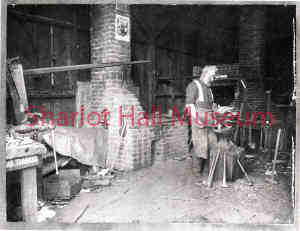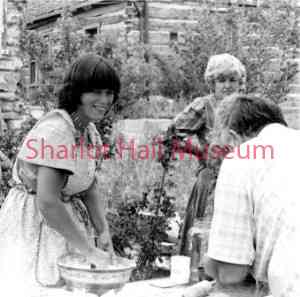By Jenny Pederson
What is folk art? Very simply, it is everyday people the world over creating works of art using traditional techniques passed down for generations. In the case of pioneers in the U.S., it often demonstrates the diverse European backgrounds of the makers.
Folk art is rooted in traditions from particular cultures and communities like Prescott and illustrate community cultural identities.
It is “felt art” rather than “taught art”. It uses a range of visual media, from everyday useful items like tin punched doors on cupboards to decorative items like hair wreaths and Yavapai baskets. Materials used include grasses, cloth, hair, wood, paper, clay, metal, leather and more. Painted folk art, also called “naïve art,” ignores traditional formal art techniques such as perspective and proportion.
For Prescott by 1900, the U.S. Census listed just over 3,500 people living in the area. It had been the territorial capital twice; mining and ranching were firmly established in the area’s economy, and the thriving frontier community was home to a variety of businesses and trades, like blacksmithing. In 1903, the Prescott City Directory listed five blacksmith shops alone.
 Blacksmiths were instrumental in frontier Arizona. Because many areas were relatively isolated with a lengthy wait for manufactured goods coming from the east, the ability to make what was required using materials at hand was critical. It was common for blacksmiths in the Prescott community to make and locally sell household items and hardware, as well as iron tools and instruments.
Blacksmiths were instrumental in frontier Arizona. Because many areas were relatively isolated with a lengthy wait for manufactured goods coming from the east, the ability to make what was required using materials at hand was critical. It was common for blacksmiths in the Prescott community to make and locally sell household items and hardware, as well as iron tools and instruments.
People learned their crafts in a variety of ways, from working on local farms and ranches, to being taught by parents or other family members, to picking up hobbies, to researching the craft and talking to practitioners. Hairwork, including weaving, braiding and flower-making, was one of the parlor arts or “fancy work” young ladies did, along with samplers, needlepoint, tatting, crochet, bead and shell work.
 The lives of children were also different. In rural areas where roads were in rough condition, it was not unusual for the school term to be shorter, often running from late fall through winter. The first Prescott schoolhouse, likely built in 1867, was a one-room structure operated during the winter months. Constructed of local Ponderosa pine, the building’s fireplace warmed students in the cold winter months. The shorter school year accommodated families who needed children to work the ranch or farm or hold a job in town. Some learned trades in their teenage years, apprenticing at blacksmith shops or with the local printer.
The lives of children were also different. In rural areas where roads were in rough condition, it was not unusual for the school term to be shorter, often running from late fall through winter. The first Prescott schoolhouse, likely built in 1867, was a one-room structure operated during the winter months. Constructed of local Ponderosa pine, the building’s fireplace warmed students in the cold winter months. The shorter school year accommodated families who needed children to work the ranch or farm or hold a job in town. Some learned trades in their teenage years, apprenticing at blacksmith shops or with the local printer.
To entertain themselves, many children played outside due to limited space inside homes. During the late 1800s, popular outdoor games and activities included croquet, quoits, jump rope and hopscotch.
Baseball was a popular pastime, and by the 1890s, the Arizona Territory was home to multiple teams. Prescott, Tucson, Phoenix, Tombstone and Fort McDowell all had teams.
 Sharlot Hall Museum’s 46th annual Folk Arts Fair reminds visitors what daily life was like during territorial days, showcases the arts and skills essential to life and reminds us that we don’t need fancy things to have a good time. Kids are encouraged to try cattle roping, gold panning, juggling and making corn-husk dolls. Visitors are encouraged to engage with demonstrators who practice historic arts and crafts and who share an appreciation for Arizona’s settlers and pioneers, including the knowledge, skills and crafts they brought to Arizona. Demonstrations include chair caning, tatting, spinning, dyeing, painting, wood carving and more. Since the Fair’s inception 46 years ago, the Sharlot Hall Museum has been proud to host these artisans and groups who keep historic traditions alive.
Sharlot Hall Museum’s 46th annual Folk Arts Fair reminds visitors what daily life was like during territorial days, showcases the arts and skills essential to life and reminds us that we don’t need fancy things to have a good time. Kids are encouraged to try cattle roping, gold panning, juggling and making corn-husk dolls. Visitors are encouraged to engage with demonstrators who practice historic arts and crafts and who share an appreciation for Arizona’s settlers and pioneers, including the knowledge, skills and crafts they brought to Arizona. Demonstrations include chair caning, tatting, spinning, dyeing, painting, wood carving and more. Since the Fair’s inception 46 years ago, the Sharlot Hall Museum has been proud to host these artisans and groups who keep historic traditions alive.
The Museum invites you to join us at this year’s event on June 1 and 2 from 10 AM to 5 PM on Saturday and 10 AM to 4 PM on Sunday. At the Sharlot Hall Museum’s Folk Arts Fair, the simple pleasures of the past are for everyone.
“Days Past” is a collaborative project of the Sharlot Hall Museum and the Prescott Corral of Westerners International (www.prescottcorral.org). This and other Days Past articles are also available at https://sharlothallmuseum.org/articles/days-past-articles.l. The public is encouraged to submit proposed articles and inquiries to dayspast@sharlothallmuseum.org. Please contact SHM Library & Archives reference desk at 928-445-3122 Ext. 2, or via email at archivesrequest@sharlothallmuseum.org for information or assistance with photo requests.


